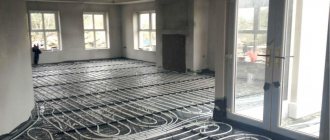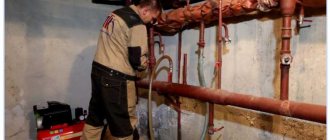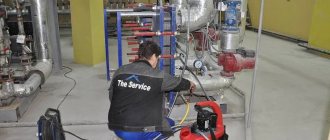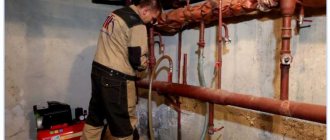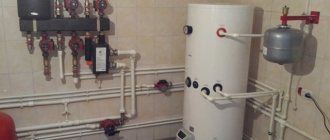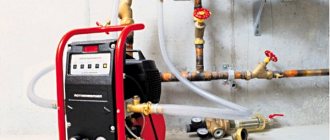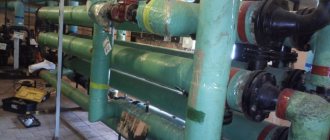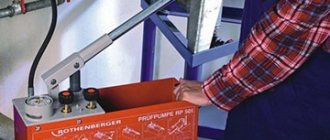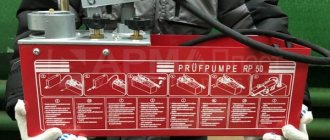There are hundreds of connections in any heating system. This is a connection of pipes and radiators, ball valves, circulation pumps and expansion tanks. In sectional batteries, the weak point is the connection of the sections to each other through a gasket; in the presence of heated floors, additional threaded connections appear between the boiler and the collector and between the collector and the floor heating system.
All these connections are checked after installation, i.e. the heating system is pressurized with air. SNiP clearly and unambiguously stipulates the norms for pressure testing of heating systems. Technically, pressure testing is carried out by creating high air or water pressure in the system to detect defects and coolant leaks.
Pneumatic and hydraulic pressure testing of pipes: how it is done
Pressure testing of a pipeline is a technological operation performed on a relatively small isolated section of the pipeline. This section is specially tested by applying high pressure, close in value to the maximum permissible. Carrying out pressure testing of pipelines allows you to verify the integrity of the line, the quality of installation work and installation of fittings.
Pressure testing is a necessary and important operation that allows you to identify weak points in the assembled pipeline
The concept of pipe crimping
Pressure testing means checking the readiness of an object for operation by applying increased pressure. The object of such a check may be a pipeline system, a container, an assembly or machine, or a separate mechanism. When we talk about increased pressure, we mean a value that is 2-3 times higher than the working pressure and is close to the maximum permissible. An object that has successfully passed pressure testing is considered suitable for use. Leaks identified during the inspection are repaired.
Important! The amount of pressure during pressure testing is regulated by regulatory documents for certain groups of objects.
Pressure testing must be carried out by a trained specialist. Relevant employees of industrial and utility enterprises are required to undergo certification. Upon completion of the tests, a report is signed indicating the date, pressure value, holding time and other information.
The pressure in the system for testing is created either by a standard pump or a special pressure tester. They check, as usual, with water. When its use, for some reason, is unacceptable, air pressure testing of pipes is carried out, which makes it difficult to detect leaks.
When is pressure testing of pipelines carried out?
All new pipeline systems, tanks, etc. are subject to pressure testing before putting into operation. All objects that have undergone repair or replacement of some element are also checked. Since the joints with installed fittings are considered to be the most unreliable sections of the pipeline, sections where coupling was used are subject to mandatory inspection.
All types of pipelines, domestic and industrial, newly built and already in operation are subject to pressure testing
Testing is also carried out in other cases:
- if the pipeline has been idle for a long time or operates in seasonal mode (like a heating system in the summer);
- if scheduled inspections are provided. In this way, the polymer sewer system is checked when the integrity of the outlet pipeline is monitored. Pressure testing of a plastic water supply is one of the most popular operations carried out after any pipe cleaning, since mechanical damage is very likely, especially at the joints;
- after flushing the pipeline, especially with the use of aggressive chemicals, which could cause damage to fittings or pipe walls;
- Wells are tested in a special way - to check whether perched water (water from the surface layers) gets into its shaft, because consumers are concerned about the quality of water, especially drinking water.
Preparation for work
Carrying out pressure testing is a responsible procedure that requires preparatory measures. Before starting pipeline testing, it is mandatory to:
- An inspection is carried out to identify visually detectable defects (corroded areas, missing parts, etc.). If violations are identified, they are eliminated. In cases where the system contains a working medium that is prohibited from being used for testing, it is customary to empty it (for example, the heating system is freed from coolant).
- The pipes are washed to remove rust, scale, and deposits of organic and inorganic origin. Some of the flushing methods require the use of a compressor. Upon completion of washing, the quality of its implementation is checked. The quality of flushing is checked by the condition of the inner surface of a half-meter section of the pipeline cut out at a randomly selected location.
To carry out work, a pressure gauge must be installed on the equipment to control the pressure.
If the injection device does not include a check valve that retains the working medium in the system, and a pressure gauge, then they are installed after completion of the tests.
It is important to know! Pressure testing of the heating system of an apartment building precedes an inspection of the work on preparing the associated heating unit. This is explained by the fact that the thermal unit is checked using high pressure values.
Mechanisms for carrying out
Crimping operators, i.e. Special pumps for carrying out relevant tests differ in design. Based on this feature, they are classified into three types:
- Porshnev.
- Vane-rotor.
- Membrane.
If testing of a pipeline (or other object) of a relatively small volume is required (for example, in private housing construction), then it can be performed using an inexpensive and easy-to-maintain manual pressure tester. This mechanism allows you to pump up to three liters of working fluid into the system in a minute.
To check the systems of a multi-story building, you will need a more powerful mechanism driven by an internal combustion engine or electric. The domestic UGO-30 is equipped with a 16-liter tank and allows you to develop a pressure of up to 30 atm. Manual two-stage pumps UGO-50 and UGO-450 are used when performing more complex tasks.
In domestic conditions, compact devices are used that can be manually controlled.
German-assembled electrically driven crimpers produced by Rothenberger (model ROTEST GW 150/4, for example, designed for testing drinking water and gas supply systems with air) and Ridgid (for example, model 1460-E 19021 are used in systems filled with as a working fluid water, oil or ethylene glycol).
SNiP and safety measures during crimp testing
The procedure for testing pipelines, technological diagrams of the pressure testing process and safety standards are determined by the relevant sections of SNiP:
- for internal sanitary systems - SNiP 3.05.01-85;
Source: https://trubamaster.ru/obsluzhivanie/opressovka-trub.html
Types and reasons for conducting
Based on the tasks set, there are three main types of pressure testing of heating systems in apartment buildings and private buildings:
- Primary. Before the heating system is ready for operation, it must be diagnosed. This is done after all parts are connected (radiators, heat generators, expansion tank). However, before the pipelines are hidden behind sheathing frames or, for example, covered with screeds. The main role is given to checking the build quality.
- Another (repeated) For preventive purposes, experts recommend performing hydraulic tests of the system annually. The most appropriate time is when the heating season is over and the system has undergone scheduled maintenance. The main task here is to prepare for the coming winter and minimize the risk of an emergency.
- Extraordinary (emergency). The act of pressure testing the heating system must be carried out if any component of the system has been repaired, for example, a radiator, boiler, etc. has been dismantled. It is believed that after the system has been flushed or started up after a long period of inactivity, it should also be pressure tested.
Pressure testing of pipelines with air SNIP
Pipeline depressurization is an extremely undesirable phenomenon that can lead to very serious consequences.
To minimize the risk of such incidents, it is necessary to ensure that the system is sufficiently reliable before putting it into operation.
A special procedure will help you do this - pressure testing of the pipeline.
- 1 Pressure testing with air and water - what is it?
- 2 When is crimping necessary?
- 3 Preparatory measures for crimping
- 4 Crimping machines, pumps for crimping pipes
- 5 How is this done?
- 6 SNiP
- 7 Safety measures when crimping pipelines
- 8 Cost
- 9 per topic
Pressure testing with air and water - what is it?
The essence of pressure testing is to fill a certain system with a closed volume - a pipeline, container, machine or mechanism - or its isolated section with a medium whose pressure is 2 - 3 times higher than the working one and almost corresponds to the maximum permissible value (the value of the test pressure for each specific case is set by the appropriate norms).
If the object passes this test, it is considered suitable for use.
Cost of hydraulic tests
It is not recommended to carry out tests of the heating system yourself, since such measures are considered quite important. It is best to entrust the work to a licensed contractor whose specialists know how to perform pressure testing of a heating system and can guarantee the high quality of the work performed.
Most often, the cost of crimping consists of the following:
- Scope of work performed.
- Technical condition of the system.
- The need to perform additional operations, including flushing, eliminating leaks, replacing control and measurement devices.
The contractor provides the customer with a contract for performing pressure testing and an estimate. In this case, a high result of the work performed in accordance with the technical specifications is guaranteed. In addition, all the results obtained will be included in an act drawn up according to certain rules.
From all that has been said above, it can be understood that pressure testing of the heating system is a fairly important and responsible event that allows you to determine the performance of the heating network.
Pressure testing of the heating system: rules and regulations snip, certificate of pressure testing of the heating system
To put the heating into operation, it is necessary to flush and pressure test the system. After completing this procedure, a certificate is filled out confirming that the installation of the heating network was done correctly. Employees authorized to perform this work are required to complete all relevant regulations.
SNiP crimping rules
The norms for pressure testing of the heating system are described in documents such as SNiP 41–01-2003, and also 3.05.01–85.
Air conditioning, ventilation and heating - SNiP 41-01-2003
Hydraulic checks of water heating systems can only be carried out at above-zero temperatures in the premises of the house. In addition, they must withstand water pressure of at least 0.6 MPa without damage to the seal and destruction.
During the test, the pressure value should not exceed the limit for the heating devices, pipelines and fittings installed in the system.
Internal sanitary systems - 3.05.01–85
According to this SNiP rule, it is necessary to check water heat supply and heating systems with the expansion vessels and boilers turned off using hydrostatic pressure equal to 1.5 working pressure, but not less than 0.2 MPa in the lower part of the system.
The heating network is considered to have passed the test if it holds the test pressure for 5 minutes and does not drop by more than 0.02 MPa. In addition, there should be no leaks in heating equipment, welds, fittings, threaded connections and pipes.
Conditions for performing crimping
Test work is carried out correctly if all necessary requirements have been met. For example, outside work cannot be carried out on the tested object, and the testing must be supervised by the shift supervisor.
Pressure testing is carried out only according to a program approved by the company’s chief engineer. It defines: the procedure for employees and the technological sequence of verification . They also outline safety measures for ongoing and current work performed at adjacent facilities.
There should be no strangers during pressure testing of the heating system; there should be no turning on or off of testing devices; only employees taking part in the test remain on site.
Permissible test pressure when testing water heating
Many developers are interested in what pressure should be used to check the heating system. In accordance with the SNiP requirements presented above, during pressure testing, pressure is allowed to be 1.5 times higher than the working pressure , but it should not be less than 0.6 MPa.
There is another figure indicated in the “Rules for the technical operation of thermal power plants.” Of course, this method is “softer”; its pressure exceeds the working pressure by 1.25 times.
In private houses equipped with autonomous heating, it does not rise above 2 atmospheres, and it is adjusted artificially: if excess pressure appears , the relief valve immediately turns on. Whereas in public and multi-apartment buildings the working pressure is much higher than these values: five-story buildings - about 3-6 atmospheres, and tall buildings - about 7-10.
Pressure testing of a heating system with air - Heating and insulation - a site about heat in your home
This technological operation is performed on new heating systems before they are put into operation.
It is also carried out after the completion of preventive or repair work on the specified systems after their complete completion, but before the restart of the specified systems into operation.
The implementation of these works is also associated with such a factor as seasonal operation of the heating system. Therefore, such work takes place every autumn on all sections of heating mains and centralized heating systems of apartment buildings.
The main task that pressure testing of a heating system with air is aimed at achieving is to identify possible places of coolant leakage from the heating system lines.
Diagram of pressure testing of an air heating system
Pressure testing of heating system with air
The crimping procedure is carried out either with water or air. The latter option is preferred in the cold season to eliminate the possibility of water freezing in the system if any defect occurs in it.
The technology for performing air crimping is quite simple. In any place convenient for you in the heating system (HC), a compressor is connected, which pumps air into the heating radiators and system lines. Its pressure rises to a predetermined value. After which the change in pressure is controlled by a pressure gauge.
In cases where the work is done efficiently, the pressure in the system does not drop over time.
Pressure testing of the heating system with air is performed in a certain sequence.
First, you need to completely drain the water from the system.
Next, you need to cover and seal the selected area of CO that is subject to subsequent monitoring. That is, the branch to be pressure tested is completely cut off from the central water conduit.
This procedure is performed using existing shut-off valves (valves or taps) located at the end and beginning of the section.
Before starting this stage of work, certain preparatory measures should be completed. Namely:
- Carry out a thorough inspection of all shut-off valves;
- If necessary, add oil seals to ensure complete sealing;
- Restore pipe insulation where necessary.
It is necessary to connect a compressor to the controlled area, the power of which is selected taking into account the internal volumes of the tested area.
Then it is necessary to create excess pressure in this area, the value of which should be no less than two to three times higher than the operating pressure specified for the CO. (That is, at an operating pressure of up to 2 atmospheres, the pressure in the system when pressurizing it with air must be brought to at least 5 atmospheres).
As a rule, the compressor is connected either to the CO drain valve or to one of the radiators, having previously unscrewed the Mayevsky valve (heating system air bleeder) from it and replaced it with an adapter that allows the compressor hose to be attached.
Compressor connection
Next, all connections in the system are checked for leaks (lack of tightness of the assembly). In this case, it is necessary to look at ALL connections, not only detachable ones, but also soldered ones (if the CO is assembled from propylene pipes).
In cases where crimping is carried out with air, all connections should be pre-coated with a soap solution. If this procedure is performed with water, then leaks will become noticeable even without it.
Air separator, what is it?
Air separators or their other name - air collectors for heating systems are designed to remove air from the coolant that circulates in the circuit. It is used for systems of any type, in underfloor heating systems and in heat pumps. Water is passed through a separator to remove dissolved gases and various contaminants that adversely affect the system and contaminate various valves. An air separator makes the question of how to properly remove air from a heating system completely irrelevant. But to increase the reliability and durability of the system, a separator and manual or automatic air vents are installed in the heating system of a home or business.
Air separators have many useful properties that improve heating circuits:
- installing a separator improves heat transfer;
- high reliability due to the extreme simplicity of the design;
- significant improvement in water quality in the circuit;
- cleaning of accumulated contaminants can be done without stopping the system;
- low cost and ease of installation;
- removal of the smallest particles of dirt from the coolant.
Consequently, the answer to the popular question - how to bleed air from the heating system - is simplified. There will be so little air in the system that tiny traces of it can be easily removed manually. For this purpose, Mayevsky taps and automatic air vents are used. There is a fundamental difference between manual and automatic air vents. The Mayevsky crane removes, for example, air pockets that have accumulated at the highest points.
The separator extracts the air dissolved in the water and removes it.
That is, when heating the water that has passed through the separator, no air will be released. Of course, using a separator for small systems is expensive; removing air manually can be done easily and simply. Air separators are most widely used in complex, large heating circuits. If you decide to buy an air separator for heating, the price will depend on the performance, ranging from 3,000 to 40,000 rubles.
Pipe crimping
Pipes can be handled in different ways. Most often, they are welded, soldered or pushed into a socket. However, in this article we will look at a completely different action - crimping pipes. Moreover, not only the process itself, as a result of which pipes are crimped, will come into our field of view, but also the technology for performing this work.
Pressure testing of water supply and heating systems - how is it done?
As a rule, the process of monitoring the integrity of pipes and the quality of joints using the crimping method can be implemented in the process of performing the following actions.
Action one: covering and sealing the controlled area. At this stage, we cut off the pipeline branch to be pressure tested from the central line of the water pipeline. To do this, you need to shut off the shut-off valves (taps or valves) at the end and beginning of the section. Well, for sewers, special plugs made of plastic, rubber or wood are used.
Step two: connecting to the controlled area a source that pumps pressure. Moreover, either a special pump for pressure testing pipes or a conventional pump responsible for circulating fluid in the system is used as such a source.
The pressure source (pump) is connected to a special outlet (pipe), the presence of which was provided for during the pipeline design process:
- Pressure testing of the heating system is carried out using special taps attached to each battery,
- the water supply can be pressurized through the connection pipe of the hot or cold water tap,
- with sewerage it is even simpler - the sediment fitting is inserted into the inspection - a special tee mounted in the outlet pipeline in increments of 40-50 meters.
The accuracy of the results and operating time depend on the power of the pump. After all, a low-power pump will increase the testing time - a simple pipe crimper will not be able to quickly fill a large pipe with the required volume of air, and a leaky joint will distort all the results of our tests.
Therefore, pumps for pressure testing must be selected based on the volumes of the pipelines being tested. So, for a home system, a supercharger that pumps a couple of liters per minute through itself will be sufficient. Well, pressure testing of heating mains involves the use of circulation pumps, which are responsible for the flow of fluid in the system, as a supercharger.
Step three: pumping air (water) and monitoring the stability of pressure in the system. At this stage, a decisive action occurs - water or air is pumped into the system through the injection pump. Moreover, the injection occurs through a back pressure valve, which does not allow water (air) to move in the direction opposite to the direction of injection.
The value of the “control” pressure depends on the pipe material. Cast iron products are tested with a pressure of 1.5 atmospheres, free-flow plastic pipes with a pressure of 1.5-2 atmospheres, and pressure pipes with a pressure of 10-15 atmospheres.
Moreover, the pressure in the pipe itself is controlled both during the 8-hour “holding” and during the injection of air (water) into the pipe. The main measuring tool, in this case, is a conventional pressure gauge. The test results are taken from the scale of this device.
Of course, the pressure gauge must be located behind the back pressure valve, otherwise you will not see any results.
As a result, the crimp control process looks like this:
- First we pump in air, monitoring the pressure using a pressure gauge,
- after increasing the internal pressure to the desired result, turn off the supercharger,
- fix the initial pressure value on the pressure gauge and leave the system for 6-8 hours,
- After the control time has expired, we compare the initial pressure value on the pressure gauge with the current result.
If there is no difference, the system is sealed. Otherwise, the system is not airtight and needs improvement.
Pneumatic and hydraulic pressure testing of pipes: how it is done
Pressure testing of a pipeline is a technological operation performed on a relatively small isolated section of the pipeline. This section is specially tested by applying high pressure, close in value to the maximum permissible. Carrying out pressure testing of pipelines allows you to verify the integrity of the line, the quality of installation work and installation of fittings.
Pressure testing is a necessary and important operation that allows you to identify weak points in the assembled pipeline
Crimping - what is this procedure?
Pressure testing of a heating system is a way to check its tightness and how well the assembly is done. This means that the system is maintained under a certain pressure for some time. Based on the results of such a check, it is already possible to judge whether the system is ready for use or not. All devices included in the system are tested for strength: heat exchangers, radiators, pumps, shut-off and control valves, etc.
Pressure testing of a building is a set of operations, among which are flushing pipelines, checking and, if necessary, replacing certain elements, and restoring the integrity of the insulation. In private buildings, in addition to the heating system, both the sewerage system and the hot water supply circuit can be pressure tested.
The crimping operation includes:
- testing of the pipeline and its complete flushing and cleaning;
- checking and, if necessary, replacing parts;
- rehabilitation of faulty thermal insulation.
Through the influence of high pressure the following is inspected:
- reliability of the housing, pipe walls, radiators, heat exchangers, fittings, etc.;
- endurance, performance and serviceability of taps, pressure gauges, valves and gate valves;
- how well the parts making up the system were secured when connected.
Pipeline pressure testing: procedure for carrying out the operation on water supply and heating utility networks
Pipeline depressurization is an extremely undesirable phenomenon that can lead to very serious consequences.
To minimize the risk of such incidents, it is necessary to ensure that the system is sufficiently reliable before putting it into operation.
A special procedure will help you do this - pressure testing of the pipeline.
